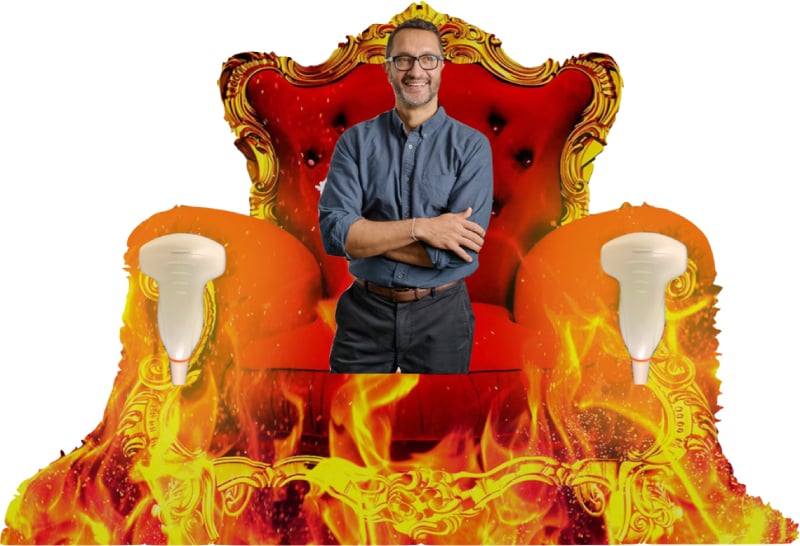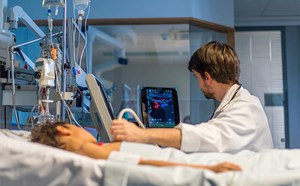
Sono Hot Seat with Arun Nagdev – On Innovation and Integration of Nerve Blocks
Arun Nagdev MD
Highland Hospital
Oakland, CA
Questions posed by Stephen Alerhand MD
Any time I see a new emergency medicine nerve block article, or need to review one as a journal editor, I assume it's from you and your team. Can you walk us through your secrets for translating regional anesthesia techniques to our emergency clinical setting? Are you reading through the anesthesia literature and seeing which blocks may apply to our patients? Or do the ideas for specific blocks first arise out of clinical need encountered during shift?
The benefit of working at Highland is that there are a group of physicians who are block fanatics and always looking for ways to implement blocks into emergency care. I specifically remember when I ran across a case series from an anesthesia group that had just gone to press (not yet in print) in regard to performing a distal sciatic block in the popliteal fossa without having to reposition a patient. I sent the article to our internal group and by the following week, we collectively had performed 4 successful blocks. Like everything else in medicine, learning and improving patient care is a team sport, and all advances come from smart clinicians trying to give better care. So yes, we look through anesthesia, pain and emergency medicine literature so we can discuss how it can best be implemented for our patients.
Faculty may be hesitant to allow their residents to perform certain blocks under their supervision (and medical license). What are some steps and ideas you recommend to overcome this? How much do you think we should or should not be pushing our faculty colleagues who are not familiar with these techniques?
Great question that I get asked all the time. I would recommend starting small and picking one block that is both common in your specific ED and not difficult to perform. Starting with an infrainguinal fascia iliaca block with 10ml of lidocaine is a nice way to think of giving your patient some pain control. I have found this block to be easily learned for even the most inexperienced ED clinician. Also, learning how to visualize the needle in-plane really gets the skill acquisition that is needed for most ED blocks. This can be done beforehand with gel phantoms or another simulator.
What would you say to a faculty colleague or department chair who expresses concern about local anesthetic systemic toxicity (LAST) or other adverse side effects? How would you reassure them? What cautions would you provide?
LAST is a real concern, and I would make sure a few things are in place before any department embarks on performing ultrasound-guided nerve blocks. First, making sure that Intralipid is easily accessible in the department with clear dosing instructions. Second, always ask clinicians to aspirate before injecting small aliquots of anesthetic (3-5ml at a time max). Finally, I would recommend using normal saline hydrodissection. This simple technique of injecting normal saline before your anesthetic, will ensure that you can see the anechoic fluid on the ultrasound screen as well as improves needle tip visualization.
All procedures in medicine have risks, and the job of the astute clinician is to recognize the risks versus benefit of the procedure. Also, if there are possibilities for risk, we need to build simplified systems that mitigate those risks.
Another clinical department such as Orthopedics or Surgery may be reluctant or less open to the performance of nerve blocks on patients who will ultimately be admitted to their service, and whose neurovascular examination they will be responsible for monitoring. How would you approach this conversation and collaboration?
This is a common problem in various departments around the country and think it stems from siloed medical care. The goal of ED blocks is simply to offer optimal pain control to patients. Working together with your colleagues to improve patient care should be the goal. Unfortunately, I have spoken to numerous ED docs who are told that they cannot perform blocks for various reasons from other departments. We got around this at my institution by working together with these services (ortho, trauma surgery, etc.) to offer timely blocks in the ED right after the patient was stabilized. Since they are going to be in the ED for numerous hours, we can watch these patients. In cases where the acutely injured patient is going directly to the OR upstairs, our anesthesia colleagues will perform blocks based on what is needed for the patient. We document every block with a standardized and timed note in the EMR so that everyone is aware of the ED block.
For a resident or fellow training in a department without a nerve block expert, what is your advice to learn and develop these techniques?
There are more and more block courses happening at various conferences (ACEP, AIUM, SAEM, ASRA, etc.). These courses are a great way to learn anatomy and speak with regional experts who can help you learn how to properly perform ED blocks. Also, there are a ton of online resources by anesthesia and ED that demystify ultrasound-guided nerve blocks. Once you are able to identify the landmarks, the next skill is to learn how to perform in-plane needle visualization. Either purchasing a gel phantom or making a home-made tofu model can allow anyone to learn how to get comfortable with needle visualization. Once these skills are mastered, I would recommend starting out with a simple/safe block.
Some barriers to resident performance of a given nerve block include a busy clinical environment, available time, and cognitive overload from managing multiple patients. These scenarios can make it overwhelming to gather the necessary supplies, and read or watch a quick refresher article or video. What are some systems- and individual-based recommendations to address this?
I am a huge fan of design thinking. Simply put, build the process around the user. We have a block cart in our ED that has needles and supplies. It even has a locked drawer with anesthetic that our ED pharmacists restock. I recognize that many places that are staring out won’t have the ability to do this, but you can make a block grab bag filled with all the supplies needed for blocks. Order the anesthetic from the nurse, grab a pre-made block bag in conjunction with your favorite ultrasound system, and take care of the patient’s pain. Make this process easy and simple. You are more likely to do it and really make a difference for your patient.
Tell us about the Blockheads Zoom group you developed, and what is your goal for this collaboration? What have been some early lessons learned? Any early successes?
I realized that there were a number of amazing ED docs around the country who were doing great things at their centers when it came to ED blocks. I wanted everyone to have a chance to meet online, discuss topics monthly. Blockheads is open to everyone and we are growing as a little community of enthusiasts. We meet once a month for 30 min and from 5 meetings we are building a great collective. We have submitted a case series from various institution, a thought piece on complications from brachial plexus block, grown the national registry for ED blocks and started an open source ED block discharge instruction set. It has been amazing and one of the best things I have done in my career. If anyone is interested in learning more, they can contact me.



